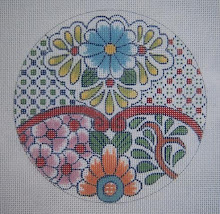 I had to have a picture of this window - they are all the way down both sides of the beautiful chapel at St. Andrews. These two saints - Francis and Clare are my favorites. St. Clare is the patroness of needlework, as she sought refuge with St. Francis when she was hiding from a suitor her father had chosen for her. St. Francis helped her establish the Order of the Poor Clares, and their work was embroidering altar cloths. I have painted her on needlepoint canvas, but have now lost the pattern.
I had to have a picture of this window - they are all the way down both sides of the beautiful chapel at St. Andrews. These two saints - Francis and Clare are my favorites. St. Clare is the patroness of needlework, as she sought refuge with St. Francis when she was hiding from a suitor her father had chosen for her. St. Francis helped her establish the Order of the Poor Clares, and their work was embroidering altar cloths. I have painted her on needlepoint canvas, but have now lost the pattern. You can also see the beautiful stained glass in almost its true cobalt blue color. When I first saw the chapel at the very beginning of this project, the only window that was placed was the big one on the east wall behind the altar.

Again, the light was dim when I was out there on Wednesday, but you can get the idea of the grandeur of it. When I first saw this, I knew I had the background for my kneelers. There are the stylized grapes and leaves you see on the finished pieces, plus the delightful texture of the "cobblestones."
There is a difference between altar rail kneelers and individual prayer kneelers, in that the space has to be considered in front of the rail, and the size and number of cushions are largely determined by this. An individual prayer kneeler only has to fit the prie dieu if there is one, or just be the size the person wants.

The color is really bad looking on this one - St. Jude, who is my very favorite of the Disciples - the patron saint of Miracles and Hopeless cases. I think the flash on my camera took over here.
I don't remember whose idea it was to use the disciples as the theme - but with St. Andrew for the center, it seemed a good idea. Marilyn Sheneman and I worked together on this project, and it was a wonderful experience. She made me laugh a lot.
To get started, I had to measure the entire space in front of the altar where the cushions would be placed - to get the measurements right for the canvases. This altar rail is very very long, so I had lots of space to fill. I knew I wanted that Star of David, and also wanted to put the Alpha and Omega at the end, but couldn't fit it into the shield format - so opted for the Chi Rho monogram.
I had the measurements all settled in my head,
 when someone informed me that there were 13 disciples, as Judas was relieved of his duties after the 30 pieces of silver episode. So - back to the drawing board to shorten the cushions and add another. 15 in all!!!
when someone informed me that there were 13 disciples, as Judas was relieved of his duties after the 30 pieces of silver episode. So - back to the drawing board to shorten the cushions and add another. 15 in all!!! As they are about 30" long, you can imagine the size of this space. Sorry - bad lighting again. I did extensive research, as I have done for years, on the lives of these men, their work, and in some cases their martyrdom - from whence come their symbols.
Right now I can't remember a lot of it, as it has been almost ten years since I did this. I have no idea why there is a rope forming the "J" but I'm sure there's a reason. The 30 pieces of silver are obvious. The next step was to go home and make zillions of sketches on white drawing paper, which I buy in rolls. - then refining the drawings to size on tracing paper, and inking the patterns.
This is how it begins when designing kneelers for the Communion rail. One must look at the surroundings - the stained glass, consider the name of the church, all of that - and then select a theme and the colors, being aware of the color of the light that comes through the windows. One does well to have continuity in the backgrounds that will tie them all together. More on this later - and more pictures.



















